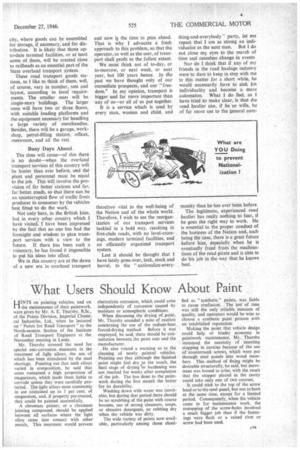What Users Should Know About Paint
Page 41

If you've noticed an error in this article please click here to report it so we can fix it.
H[NTS on painting vehicles, and on the maintenance of their paintwork, were given by Mr. A. E. Thursby.
of the Paints Division, Imperial Chemical Industries, Ltd., when he lectured on "Paints for Road Transport" to the North-eastern Section of the _Institute of Road Transport Engineers at the November meeting in Leeds.
Mr. Thursby stressed the need for special ant;-corrosion measures in the treatment of light alloys, the use of which has been stimulated by the steel shortage. Pointing out that such alloys varied in composition, he said that some contained a high proportion of magnesium, which made them liable to corrode unless they were carefully protected. The light alloys most commonly in use contained up to 3 per cent, of magnesium, and, if properly pre-treated, they could be painted successfully.
A chromate primer, or a chromate jointing compound, should be applied between all surfaces where the light alloy came into contact with other metals. This treatment would prevent electrolytic corrosion, which could arise independently of con osion caused by moisture or atmospheric conditions.
When discussing the drying of _paint, Mr. Thursby sounded a note of caution concerning the use of the radiant-heat forced-drying method. Before it was employed, he said, there should be consultation between the paint user and the manufacturer.
He also voiced a warning as to the cleaning of newly painted vehicles. Pointing out that although the finished paint might feel dry to the touch, the final stage of drying or hardening was not reached for weeks after completion of the job. The less done to the paintwork during the first month the better for its durability.
Washing down with water was inevitable, but during that period there should be no scrubbing of the paint with coarse brooms, use of strong cleansers, soaps, or abrasive detergents, or rubbing dry when the vehicle was dirty.
The wide variety of paints now available, particularly among those ciassi
fied as " synthetic" paints, was liable to cause confusion. The test of time was still the only reliable measure of quality, and operators would be wise to choose a synthetic paint process with an established reputation.
Making the point that vehicle design could help or hinder economy in paintwork maintenance, Mr. Thursby instanced the necessity of inserting stopping in cavities because of the use of countersunk screws, which were put through steel panels into wood members. This method of fixing might be desirable structurally, he said, but movement was bound to arise, with the result that the stopper placed in the cavity could take only one of two courses.
It could stick to the top of the screw head or to the steel panel, but not to both at the same time, except for a limited period. Consequently, when the vehicle came in for maintenance work, the restopping of the screw-holes involved a much bigger job than if the fastenings were flush or a raised rivet or screw had been used.




































































